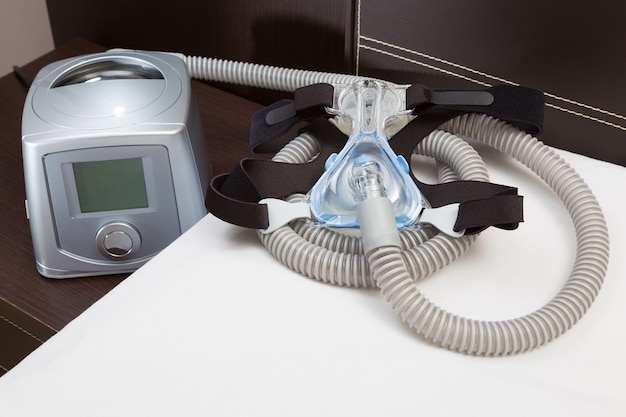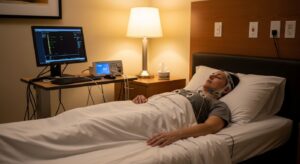CPAP therapy is a common treatment for sleep apnea. It helps keep airways open during sleep. This therapy can significantly improve sleep quality and reduce daytime fatigue.
Understanding CPAP therapy is crucial for those diagnosed with sleep apnea. It involves using a CPAP machine that delivers a continuous stream of air. This prevents airway collapse and ensures a restful night’s sleep.
Starting CPAP therapy can be daunting for beginners. There are various CPAP mask types to choose from, each suited to different needs. Proper mask fit is essential for comfort and effectiveness.
CPAP compliance is key to successful treatment. It’s important to use the machine every night for the entire sleep duration. Consistent use can lower the risk of cardiovascular issues linked to untreated sleep apnea.
Common CPAP side effects include nasal congestion and dry mouth. These can often be managed with simple adjustments. Regular CPAP cleaning is vital to prevent infections and ensure the machine functions properly.
Support groups and online forums can provide encouragement and tips for new users. Educating family members about CPAP therapy can foster a supportive environment. With the right guidance, CPAP therapy can lead to better sleep and improved health.
What Is CPAP Therapy and How Does It Work?
CPAP stands for Continuous Positive Airway Pressure. It is a treatment used to manage obstructive sleep apnea. By delivering a consistent stream of air, CPAP prevents the airway from collapsing during sleep.
A CPAP machine consists of three main components:
- The machine itself, which generates the air flow.
- A hose that connects to the machine to deliver the air.
- A mask that fits over the nose or mouth to direct the air into your airways.
Various CPAP mask types are available, tailored to individual preferences and needs. These include nasal masks, full-face masks, and nasal pillow masks. Choosing the right mask is crucial for comfort and therapy success.
The machine can often be adjusted to provide the correct air pressure. This is typically determined during a sleep study. Some machines even have auto-adjusting features to modify pressure based on your needs.
CPAP therapy can seem challenging initially. However, understanding its function helps ease the transition. Knowing how each component works can empower users to get the most from their treatment.
Why CPAP Therapy Is Important for Sleep Apnea Treatment
Sleep apnea affects millions, leading to disrupted sleep and daytime fatigue. Untreated, it can increase the risk of serious health issues. CPAP therapy offers a proven solution to address these concerns.
By keeping the airway open, CPAP improves the quality of your sleep. This translates into feeling more refreshed and alert during the day. Consistent use can significantly enhance your life and energy levels.
Consider the broader health benefits of CPAP therapy, which include:
- Lowering the risk of heart problems and stroke.
- Improving blood pressure control.
- Reducing the risk of diabetes complications.
Engaging with CPAP therapy not only aids in better sleep. It also plays a critical role in mitigating health risks. Adherence to CPAP therapy positions you for long-term well-being. Understanding and valuing its benefits is key to maintaining compliance.
Getting Started: CPAP for Beginners
Beginning CPAP therapy can feel daunting. With the right approach, it becomes manageable and effective. Understanding the basics is your first step.
Start with a sleep study to determine your specific needs. This helps set the correct pressure for your CPAP machine. Consistent use every night is crucial for success.
It’s normal to feel uncomfortable at first. Patience is key as you adjust to this new routine. Gradually increase the time you wear the mask each night.
Here are quick steps to help you settle in:
- Set up your machine in a quiet, comfortable space.
- Learn how to operate and adjust your CPAP machine.
- Experiment with wearing your mask while awake to get used to it.
Remember, there are different CPAP mask types. Nasal masks, full-face masks, and nasal pillows offer various options. Choose one that fits well and feels comfortable. Your comfort level is vital to maintaining CPAP compliance. Support groups and resources can offer valuable insights and encouragement.
Choosing the Right CPAP Mask: Types and Fit
Selecting the right CPAP mask is crucial. It affects how comfortable and effective your therapy will be. There are several CPAP mask types available to suit different preferences.
Nasal masks cover the nose and are ideal for those who move around while sleeping. They provide a good seal and suit varying pressure levels. Meanwhile, full-face masks cover both the nose and mouth, which is beneficial for mouth breathers or those with nasal obstructions.
Nasal pillow masks are smaller and sit at the nostrils. They offer a less intrusive option and are lighter. This style is preferred by those who feel claustrophobic with larger masks.
Consider these when selecting your mask:
- Determine whether you breathe through your nose or mouth.
- Test for mask comfort and seal.
- Check compatibility with your CPAP machine.
by Danilo Batista (https://unsplash.com/@hiddenwindows)
Fit is key for effectiveness and comfort. A poor fit can lead to air leaks and skin irritation. Make sure to try different sizes and styles before settling on one. Your healthcare provider can also assist with fitting to ensure optimal results. Addressing discomfort promptly helps improve CPAP compliance and overall effectiveness of the sleep apnea treatment.
Common CPAP Side Effects and How to Manage Them
CPAP therapy is generally safe, but some users experience side effects. These can typically be managed with small adjustments. Understanding these side effects and solutions can enhance your CPAP experience.
A common side effect is nasal congestion or dryness. Using a humidifier with your CPAP machine can alleviate this discomfort. Alternatively, a saline nasal spray may offer relief.
by Laura Chouette (https://unsplash.com/@laurachouette)
Some people report dry mouth, especially if they use a nasal mask. Switching to a full-face mask might help. Additionally, using a chin strap can prevent your mouth from opening during sleep.
Skin irritation from the mask is another concern. Make sure your mask fits properly and consider using mask liners to reduce friction. Cleaning your mask regularly can also prevent irritation caused by bacteria build-up.
To manage common CPAP side effects, consider:
- Adjusting humidity levels
- Trying different mask types
- Maintaining regular cleaning schedules
If side effects persist, consult your healthcare provider. They can offer tailored advice to address your concerns and ensure you remain compliant with your therapy. Adapting early can prevent disruptions and lead to more successful sleep apnea treatment.
Essential CPAP Therapy Tips for Success
Achieving success with CPAP therapy requires more than just using the machine. Following a few key tips can significantly improve your experience and outcomes. These strategies are designed to increase comfort and effectiveness.
Begin with finding a mask that fits comfortably. A good fit minimizes leaks and maximizes therapy efficiency. Trying different CPAP mask types can help you discover what works best for you.
by Elena Leya (https://unsplash.com/@foodistika)
Consistency is crucial for successful therapy. Use your CPAP machine every night, even during naps. This helps your body adapt and enhances the therapy’s effectiveness. It’s a commitment that pays off with improved sleep quality.
Tracking your therapy progress can be insightful. Many CPAP machines now come with tracking features. These offer valuable data about your usage and sleep patterns. Utilize these to make informed adjustments.
To succeed with CPAP therapy, consider these tips:
- Maintain a regular sleep schedule
- Gradually increase usage time if starting new
- Adjust your sleeping position to prevent mask displacement
Regularly clean your equipment to prevent infections and maintain efficiency. Make a habit of following recommended CPAP cleaning tips. This simple routine can make a large difference in how your therapy feels.
Support is a key component of success. Engage with support groups or online forums for encouragement. Sharing experiences and learning from others can make the journey easier. Remember, small changes and persistent effort can lead to long-term benefits.
CPAP Compliance: Building Good Habits and Overcoming Challenges
Achieving CPAP compliance is vital for effective sleep apnea treatment. Consistent use ensures that your therapy delivers the intended benefits. Compliance is the key to harnessing the full potential of CPAP.
Establishing a nightly routine can greatly help with compliance. By integrating CPAP into your bedtime habits, it becomes second nature. Simple adjustments to your routine can make a significant difference.
Users often face challenges like discomfort or noise from the machine. Addressing these early can prevent long-term issues. For instance, using a CPAP humidifier can reduce dryness and improve comfort.
To boost compliance, consider these strategies:
- Gradually increase usage over time
- Experiment with different mask types for better comfort
- Seek guidance from healthcare providers for persistent issues
Don’t hesitate to reach out to your doctor if problems arise. They can offer tailored solutions or adjustments. Remaining proactive in your approach is crucial. Embrace CPAP compliance as a pathway to better sleep health.
CPAP Cleaning Tips: Keeping Your Equipment Safe and Effective
Keeping your CPAP machine clean is essential for both safety and effectiveness. Regular cleaning helps prevent infections and extends your device’s lifespan. Maintaining cleanliness ensures optimal performance.
Most CPAP equipment requires daily and weekly cleaning. This includes masks, hoses, and humidifiers. Develop a schedule to remind yourself to clean regularly. Consistency is key to thorough maintenance.
When cleaning, use mild soap and warm water. Harsh chemicals can damage your equipment. Rinse thoroughly to remove any soap residue. Proper rinsing is crucial to avoid skin irritation.
Here are some essential CPAP cleaning tips to follow:
- Wash masks and hoses daily
- Clean humidifiers every week
- Replace filters regularly as instructed
by Emma Ou (https://unsplash.com/@emmaou)
Store equipment in a clean, dry place away from sunlight. Avoid leaving parts exposed to contaminants. A designated storage area can help maintain cleanliness and keep your CPAP machine in top condition.
Troubleshooting Common CPAP Problems
Many CPAP users encounter common issues that can disrupt their therapy. Understanding and addressing these problems is vital for effective treatment. Knowledge equips you to manage these challenges better.
One frequent issue is air leaks. Leaks often happen if the mask doesn’t fit well. Adjusting the mask or trying different CPAP mask types can help solve this problem.
Another common concern is skin irritation. To reduce discomfort, ensure your mask fits snugly but not too tight. Using barrier creams may also help lessen irritation.
Sometimes users experience dry mouth or nasal congestion. Adding a humidifier can alleviate dryness. Nasal sprays or humidifier settings can ease congestion.
Here are some common CPAP problems and solutions:
- Air leaks: Adjust or replace the mask
- Skin irritation: Use creams and ensure proper fit
- Dry mouth: Add a humidifier
- Congestion: Use nasal sprays
It is important to regularly check your equipment for wear and tear. Replacing worn parts can prevent malfunctions and improve your therapy experience. Small adjustments often result in big improvements.
Lifestyle Changes and Additional Sleep Apnea Solutions
In addition to CPAP therapy, lifestyle changes can significantly aid sleep apnea treatment. Incorporating healthy habits enhances the efficacy of CPAP. These changes often involve diet and exercise.
Losing weight can reduce the severity of obstructive sleep apnea. Even modest weight loss can make a difference. Reducing alcohol intake also helps since alcohol relaxes the muscles, worsening apnea.
Positional therapy is another effective strategy. Sleeping on your side instead of your back can minimize airway obstruction. Here are some lifestyle changes that complement CPAP therapy:
- Weight loss
- Reduced alcohol consumption
- Positional therapy
Implementing these adjustments supports CPAP therapy. Consult with a healthcare provider to determine the best approach. Regular follow-ups ensure continued success and optimal health outcomes.
Support, Resources, and When to Seek Help
Navigating CPAP therapy can feel overwhelming. Support from others on the same journey can make a difference. Exploring available resources can provide valuable insights.
Online forums and local support groups can offer guidance. Engaging in these communities provides practical tips and encouragement from experienced users. Sharing challenges and successes often boosts morale.
If struggles with CPAP persist, consult a healthcare provider. Seeking professional advice ensures issues are addressed promptly. Consider the following resources for further assistance:
- Online forums and support groups
- Consultations with healthcare professionals
- Educational materials from CPAP manufacturers
These resources enhance your CPAP experience. Addressing concerns quickly prevents prolonged discomfort and promotes therapy success.
Conclusion: Embracing CPAP Therapy for Better Sleep and Health
Embracing CPAP therapy can transform your quality of life. With consistent use, it enhances sleep and reduces related health risks. The key to success lies in understanding your equipment and maintaining regularity in its usage.
Though initial challenges may arise, persistence paves the way for improvement. By addressing issues early and utilizing available resources, therapy can become more manageable. Ultimately, sticking with CPAP can lead to profound benefits, contributing to better overall health and well-being.





